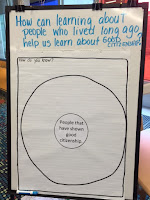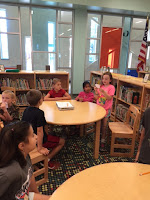A fun way to help students learn about authors in my library is placing mini-posters of author biographies on display. Students gravitate towards the appealing display and then end up checking out their books.
You can find the author bios here.
Friday, November 13, 2015
Saturday, September 19, 2015
Texas Bluebonnet Books
This next week I'm going to try out a new way to introduce this year's list... judging the book by its cover. This will be how I introduce the books to the 4th grade students who are already familiar with the program, but perhaps not this year's list.
Instead of me going blah, blah, blah... and some listening and some not, about each book, they will get to spend quality time browsing book covers, book trailers and making up their own minds about which books they hope to read this year.
Can't wait to see how it turns out... cross your fingers technology will be working!
Get the handout here: Can we judge a book by its cover? It's a freebie!
Update - loved this way to introduce the Texas Bluebonnets! Here you can see my students digging in and really looking at the book trailers. First we looked at the book covers and then I encouraged them to first view book trailers of the book covers that didn't appeal to them. Many actually changed their minds after viewing the book trailers. Can't wait to see if they keep up with this tool to help them with voting later on in January.
Instead of me going blah, blah, blah... and some listening and some not, about each book, they will get to spend quality time browsing book covers, book trailers and making up their own minds about which books they hope to read this year.
Can't wait to see how it turns out... cross your fingers technology will be working!
Get the handout here: Can we judge a book by its cover? It's a freebie!
Update - loved this way to introduce the Texas Bluebonnets! Here you can see my students digging in and really looking at the book trailers. First we looked at the book covers and then I encouraged them to first view book trailers of the book covers that didn't appeal to them. Many actually changed their minds after viewing the book trailers. Can't wait to see if they keep up with this tool to help them with voting later on in January.
Mission Possible
As part of a project-based learning, I was invited to help 2nd graders research historical figures that showed good citizenship. This is an important TEK in Texas Social Studies. So I wanted to tie the lesson of learning about historical figures with a library skill aligned with AASL standards (American Association of School Libraries).
Find the lesson here: Historical Figures Teach Good Citizenship
For the lesson, students would be diving into a short (45 min.) research lesson, learning how to find biographies about specific historical figures in an online database, closely reading the short biography with a partner and drawing a conclusion of what character trait that person showed and giving evidence.
This was an undertaking, but well worth the time it took me to prepare the lesson and the effort both the teacher and myself had to give for the students to be successful.
Students were amazingly able to figure out the gist of what these historical people did and how it related to the good citizenship traits. I won't lie, there was guidance... pointing to a specific paragraph, or showing read-aloud features, or trouble-shooting technology, but the kids really got the idea.
Each pair were able to complete a card, share what they learned with the group and conclude that learning about "old people" can help us learn to be good citizens. The cards left over were sent back to the classroom to be added to a literacy center and blank cards were sent as well. Students were encouraged to use the blank cards to add people they knew to the circle map in the classroom. Of course evidence of the good character trait has to be included!
Find the lesson here: Historical Figures Teach Good Citizenship
For the lesson, students would be diving into a short (45 min.) research lesson, learning how to find biographies about specific historical figures in an online database, closely reading the short biography with a partner and drawing a conclusion of what character trait that person showed and giving evidence.
This was an undertaking, but well worth the time it took me to prepare the lesson and the effort both the teacher and myself had to give for the students to be successful.
Students were amazingly able to figure out the gist of what these historical people did and how it related to the good citizenship traits. I won't lie, there was guidance... pointing to a specific paragraph, or showing read-aloud features, or trouble-shooting technology, but the kids really got the idea.
Each pair were able to complete a card, share what they learned with the group and conclude that learning about "old people" can help us learn to be good citizens. The cards left over were sent back to the classroom to be added to a literacy center and blank cards were sent as well. Students were encouraged to use the blank cards to add people they knew to the circle map in the classroom. Of course evidence of the good character trait has to be included!
Sunday, August 2, 2015
Be a Dewey Detective
Instead of telling, it's best to explore the answers for yourself. That is how this lesson is designed. Students are introduced to the organization of the nonfiction section with a picture of Melville Dewey, a poster and some books. Then the majority of the lesson students explore and gather clues to how the section is organized. Find the handouts and more specifics for this lesson by following this link, Be a Dewey Detective.
 |
| The carpet I have in my story area that I use starting in Kinder talking about the nonfiction section. Worth the money! |
 |
| I take the following image to Office Max and have it enlarged. My students use it all the time to help them find books. |
Subscribe to:
Comments (Atom)















